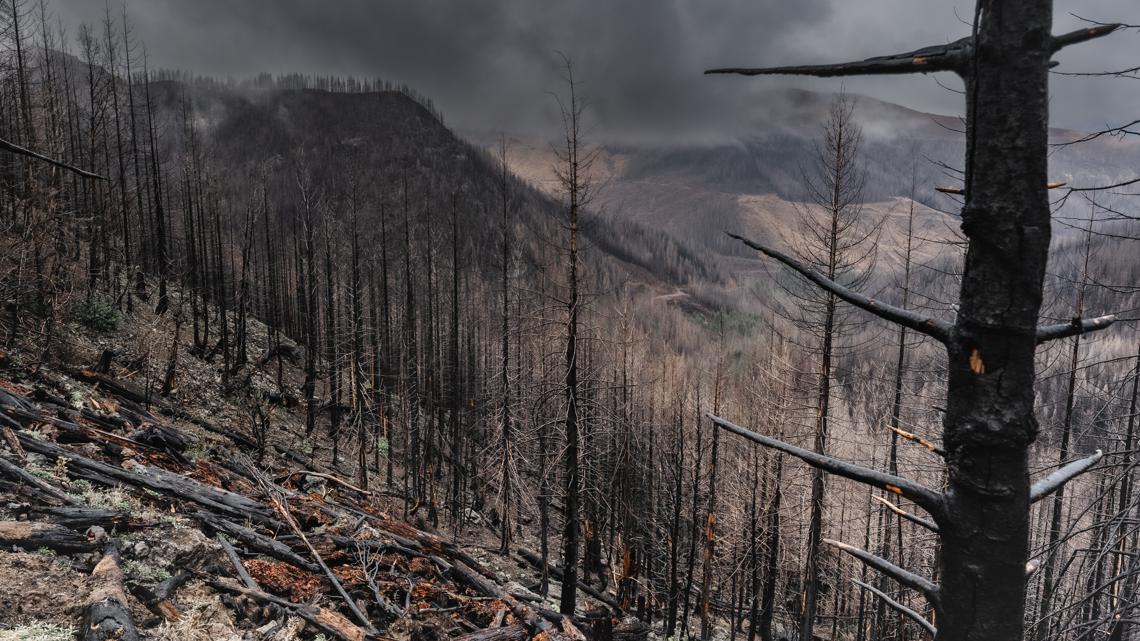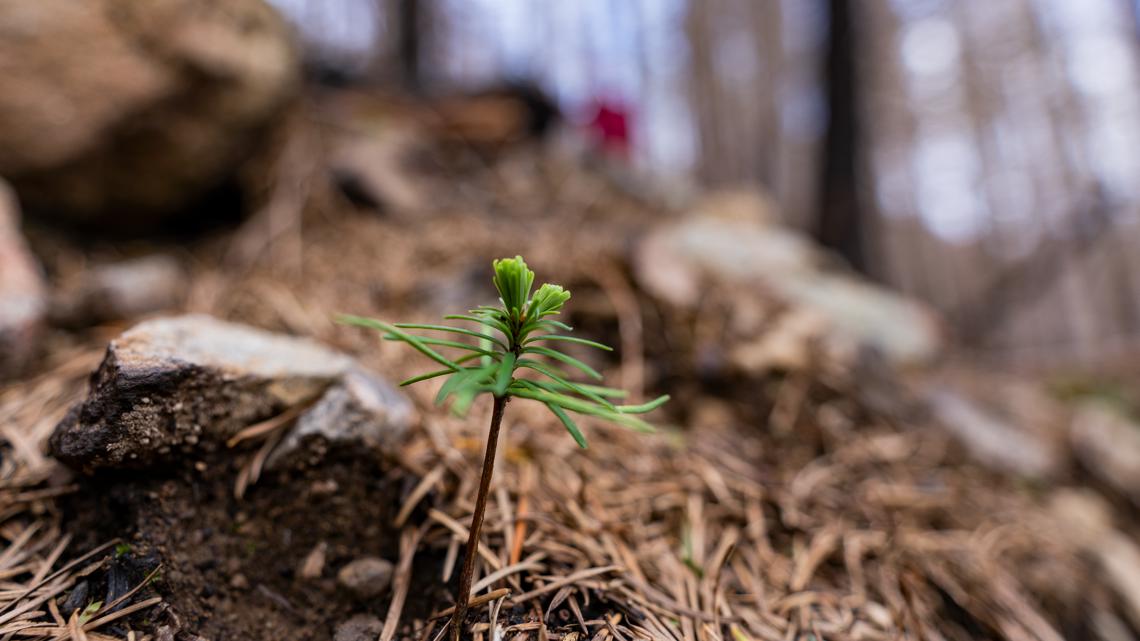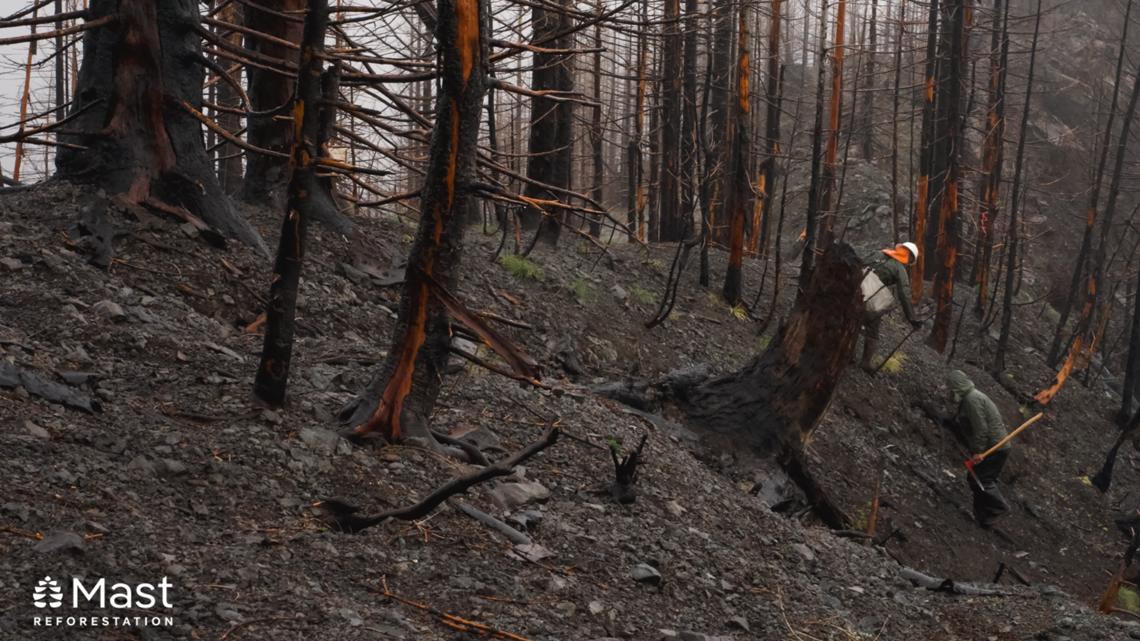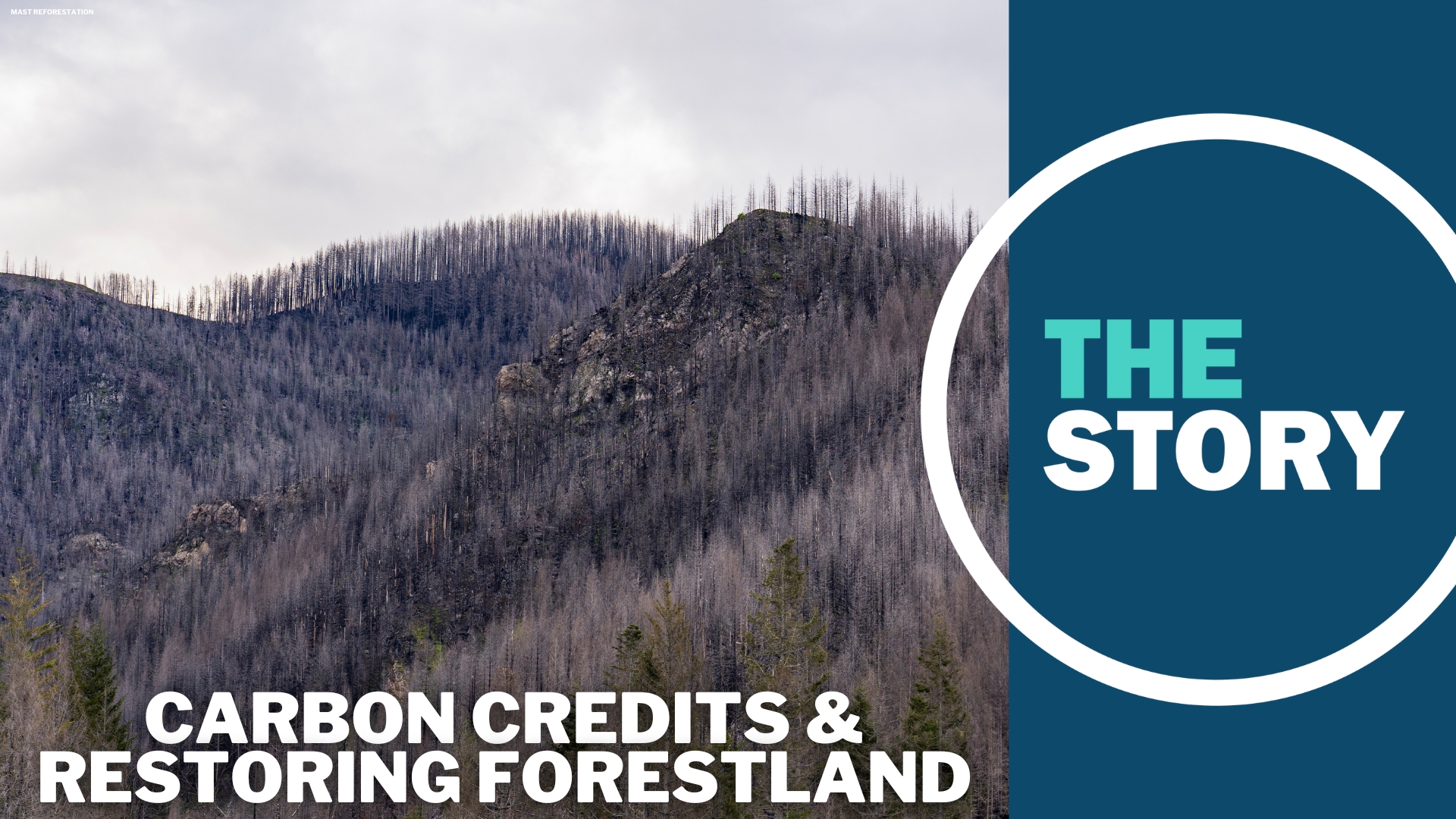MOLALLA, Ore. —
The aftermath of modern-day wildfires can be desolate. The trees that remain standing are charred, ash covers the landscape and even the dirt itself is scorched.
“When you first get there, it's a shocking sight,” said Matthew Aghai, describing the scene of a burned area in the Henry Creek watershed, southeast of Portland. “It looks like a moonscape or a hellscape after these wildfires.”
Aghai is the chief science officer for Mast Reforestation, a company that specializes in recovering burned areas like the one at Henry Creek.
“We're looking at these hellscapes with a degree of optimism,” he said.
His optimism comes from the company's novel approach to reforestation, which also seeks to stem the rising severity of wildfires.
“Our goal is to use a pathway to reforestation to mitigate the worst effects of climate change,” he said.
The novelty of their approach comes in the form of carbon credits, which they sell to help fund the costly endeavor of restoring forestlands, offering their services to landowners at steep discounts.
“As soon as trees are put in the ground, they're accumulating carbon and creating wood,” Aghai said. “That's something we want to protect and create resilience for on a very long, decadal-, century-long timeline.”
A new type of wildfire
The Beachie Creek Fire started innocuously enough. A lightning storm moved through the Cascades in August of 2020 and ignited several small blazes, including the Beachie Creek Fire in the Opal Creek Wilderness east of Salem.
The fire was remote and hard to get firefighting resources to, so crews worked as best they could to keep the blaze from growing. After several weeks, it had burned just 775 acres.
That changed over Labor Day weekend. A powerful windstorm blew in from the east and the previously small fires exploded.
The Beachie Creek Fire would merge with two others, the Lionshead and P-515, to burn more than 400,000 acres.
Aside from the vast scale of the destruction left by the wildfires, with several communities in the Santiam Canyon devastated, the conflagrations were notable for their severity.


Forests in western Oregon have evolved to endure periodic, low-intensity burns, but the Labor Day fires scorched the landscape at unprecedented levels
“It effectively devastated everything from the soil up, the seed banks up, for a large continuous area,” Aghai said, explaining that a natural reforestation of the land would have taken a long time.
“The fires are burning so hot that they're devastating not only the soil, but everything through the canopy,” he continued. “They're so large that the distance to get seed to naturally repopulate that site is too high.”
How to regrow a forest
The main ingredient in reforestation is no secret. To rebuild a forest, you need trees.
That’s what led Mast to acquire a small, family-run company in Roy, Washington called Silvaseed in 2021.
Silvaseed has been around, under a few different names, for more than 150 years. The company specializes in procuring, storing and germinating conifer seeds and seedlings.
Access to conifer seedlings has traditionally been a chokepoint for reforestation efforts.
Kea Woodruff is the general manager at Silvaseed and explained the painstaking process that each seed goes through before it becomes a tree.
“The only way to get seed for regrowing forests is to go out in the forest and collect that seed,” she said, explaining that the company works with professional seed collectors who climb trees across the west to collect cones.


Each bushel of cones is marked with the exact location it was collected, including the elevation, so that any seedlings from that batch will be well-suited for wherever they end up.
“Making sure that we’re growing trees that are fit for the area that they’re going to be planted is a really critical part of reforestation,” Woodruff said.
Once the cones arrive at Silvaseed, they’re stored in a building affectionately called the “cone barn” before they go into a kiln to dry them out and open the scales that contain the seeds.
Then they go through a series of modified old agricultural machines, over rotating brushes and vibrating screens.
“A lot of our equipment, post-cone opening, is just shaking cones to get the seeds out,” Woodruff said.
After the seeds are fully cleaned of all the pitch and needles, a sample of each batch is sent to an on-site lab where they’re X-rayed and tested for viability. Once they pass all the tests, they’re ready for either seeding or storage.
Silvaseed has one of the largest commercial seed vaults in the country, a massive storage locker kept below freezing and filled with conifer seeds.
“Most of the seed we process is orthodox, meaning it can be stored for a very long time at cold temperatures,” Woodruff said. “We have some seed in our vault that’s been here since the '60s.”
For the seed that’s ready to sow, it heads through a semi-automated assembly line process that inserts the seed into biodegradable paper pots that are ready for planting.
The assembly line can produce up to 136,000 of these paper pot seedlings each day. All of them end up just down the road at Silvaseed’s massive greenhouses, each one with a capacity of roughly a million seedlings.
While most of her time is taken up by the day-to-day operations of Silvaseed, Woodruff said she does frequently pause to think about the role the company plays in a larger sense.
“It's constantly on my mind,” she said. “What kind of fires are we going to have this summer? Are we going to be able to get the seeds that we need? Are we going to see fires in new places? Are we going to see fires in places that we don't already have seed for?”
And while the work can be taxing, it has its rewards, too.
“Every single time there's a fire, it's like, 'OK, who are the people that are going to be affected by this fire and what resources can we bring to bear on that,'” she said.
The balancing act of carbon credits
The biggest hurdle to reforesting a burned area is often the cost. Planting the trees themselves — sometimes using seed pucks dropped by heavy lift drones, but more often planted by hand — is labor intensive.
But there’s also the costs of rehabilitating roads to access the often-remote areas, seed collection, nurseries like Silvaseed and preparing the site for planting.
When all those costs fall on landowners, it can often be prohibitively expensive.
“We allow the landowner to reduce their cost burden by using a combination of those financial solutions from the markets, but also grants and other administered funds,” Aghai said.
The market-based financial solutions Aghai referred to are carbon credits.
Trees can store large amounts of carbon, one of the primary climate change drivers. Mast sells carbon credits to individuals or companies looking to offset their carbon emissions, essentially canceling out the carbon emitted from smokestacks with the carbon stored in trees.
But not everyone is convinced that using forest-based carbon credits is the best way to fight climate change.
Grayson Badgley is a research scientist with Carbon Plan, a nonprofit that analyzes climate solutions for their effectiveness.
And his skepticism stems from the very nature of offsets.
“In this carbon offsetting framework, you're making a really interesting trade,” he said. “You burn some fossil fuel, and you add that carbon dioxide to the atmosphere, but you trade that for the promise of a good thing happening somewhere else.”
Properly tracking that tradeoff over extended periods of time can be tricky, though.
Carbon dioxide degrades in the atmosphere very slowly, sometimes persisting and heating the earth for up to 1,000 years. Forests, on the other hand, are inherently temporal, with individual trees dying naturally or whole swaths of wilderness being wiped out en masse in situations like wildfires.
When trees die, they can release all that carbon dioxide back into the environment.
“If there's an imbalance between the harm done to the atmosphere and the good done to the atmosphere, what we end up with is the atmosphere actually being in a worse place than if we had just gone directly and regulated those emissions straightforwardly,” Badgley said.
Aghai recognized the point Badgley was making, but said he thinks that the resilience of forests will win out over time, especially when scaled up.
“We think about the individual tree or stand, of course, there's going to be dynamism,” he said. “Trees fall down, new trees are going to grow. When we plant more trees, they're going to reproduce.”
And when carbon emissions are offset, that helps to mitigate the risk from things like catastrophic wildfires and will help instill faith in carbon credits.
“As soon as we do that at a very large scale, we start to see that the impact and the resilience are much better,” Aghai said. “The outlook is much better, and it should create confidence in these markets.”


Progress at Henry Creek
Within a few months of the embers cooling at Henry Creek, Mast was already in talks with the landowner. Things moved quickly from there.
“Within a year and a half to two years we had already gotten the first tranche of seed out to the site,” Aghai said.
The trees are a mix of Ponderosa pine, Douglas fir and other local conifers that are suitable to the area. With consecutive rounds of planting in the years since, some 160,000 seedlings have been sowed at the 300-acre site.
And the carbon credits sold account for more than 200,000 metric tons of carbon dioxide. That’s roughly the equivalent of the yearly emissions of 47,000 cars.
Mast signed a 200-year conservation easement with the landowner, with plans to do rigorous surveys in the years and decades to come.
Still, Aghai said that work being done by his company is only part of the solution.
“The future of the Western landscape is really dependent on this combination of tending to natural systems that have natural resilience," Aghai said. "But also working as fast as we can to quickly recover these, these hellscapes."

